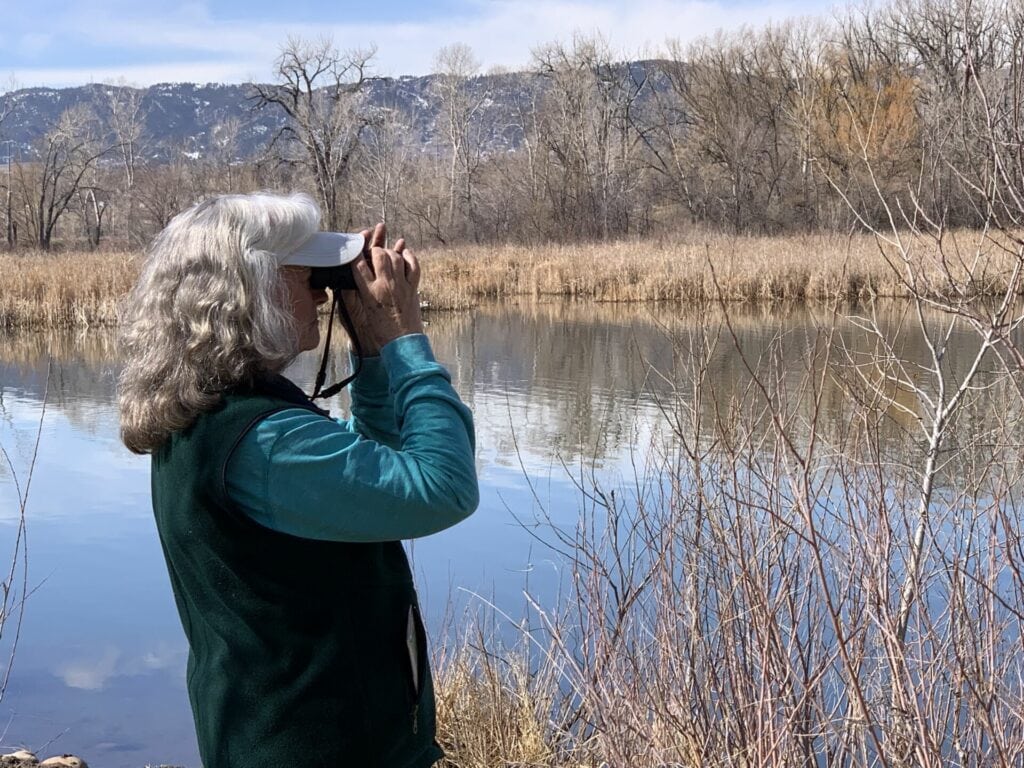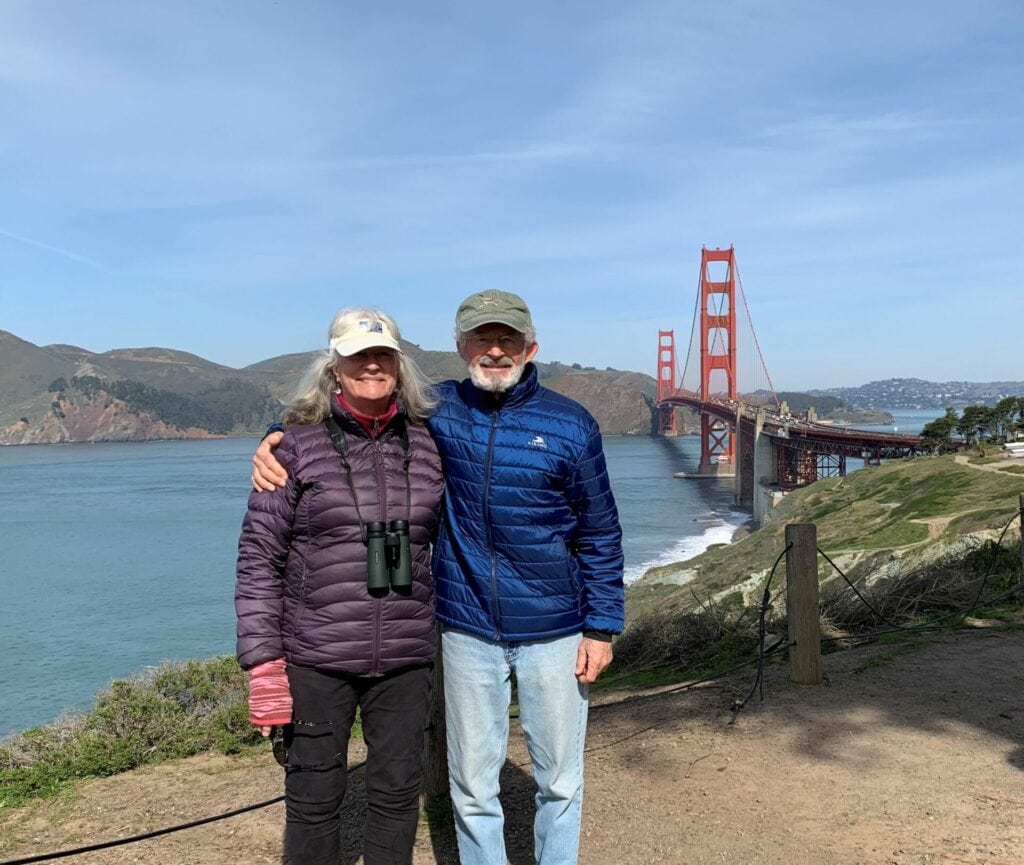How to Thrive as an SOB (Spouse of Birder)
By Kim Marvel

My wife is a birder. The early signs were subtle. Years ago, she requested my assistance placing feeders and nesting boxes in our backyard. On occasion she signed up for local birding walks. She populated our landscaping with bird-friendly shrubs and trees. Her growing interest became more evident when she placed a heated bird bath on our back deck in the winter. Now, in her retirement years, she’s completely out of the closet as a fully-fledged birder. The kitchen counter is piled with binoculars, spotting scopes, birding magazines, and Feeder Watch forms. National Audubon and the Cornell Lab are on the top of our charitable contributions list. We are frequent flyers at the local Wild Birds Unlimited store. At home, the top of each hour is cheerfully announced by a bird song emitting from the Audubon wall clock. Merlin is among her phone apps. She routinely opens her laptop to update her e-Bird list. As I write this, the centerpiece of our dining room table is a partially completed bird-themed jigsaw puzzle. Nowadays, our road trips are often organized around birding hotspots. Yes, it’s safe to say birding has become her favorite activity.

I’m not a birder. Don’t get me wrong, I do enjoy watching a colorful hummingbird or spotting a majestic raptor soaring above. On a recent outing, I was enthralled by the unique courting ritual of the Greater Prairie Chicken. Indeed, it is satisfying to recognize a species or common birdsong. It is not that I dislike birding. I just don’t have the innate curiosity and interest that I witness in my wife. I don’t have the “fire in the belly” that I observe in birders, particularly when they gather in groups. Try as I might, I don’t experience the sheer delight in my wife’s eyes upon seeing a new species.
Being a “birder”, of course, is not an either/or quality. At one extreme of the “bird interest” scale are people oblivious to bird activity. Others, like me, have a modest interest. We can recognize iconic birds such as the bald eagle, robin, cardinal, and great horned owl. While we enjoy spotting a colorful bluebird or hearing the cheerful song of a meadowlark, our interest in ongoing observation or detailed classification of species fades quickly. Toward the middle of the continuum are those who enjoy their neighborhood birds. They maintain feeders and birdbaths, can identify local species, and are observant of annual migrations. A qualitative difference exists between those of us on the lower end of the scale, who watch birds from the sideline, and those on the higher end, who eagerly enter the playing field.
Toward the upper end of the scale are serious birders. They venture out to seek new birding experiences. From my observations, serious birders possess a combination of keen hearing and/or sharp eyesight, a penchant for the scientific process of identifying and classifying species, enjoyment of the outdoors, and a genuine curiosity and love for birds. They find the process deeply satisfying and can continue the search for hours or days. The interest is genuine and comes naturally. Also toward the top of the scale are the professionals and those volunteer guides who have dedicated years to develop a deep and broad knowledge base. Some embark on trips to exotic locations to add to their life list. Clearly, birding interest is not black or white, it exists on a continuum. On a 1-10 scale of bird interest, I’m a three whereas my wife rates an eight.

Believe me, I have made an honest attempt to become a birder, to move up the scale of interest. I can quickly name several species in our backyard. Accompanying my wife on nature trails, I have learned to recognize the calls of common songbirds. On occasion, I have proudly pointed out a nuthatch or ouzel based on their characteristic behavior. Indeed, when decked out with my vest, hat, and my wife’s hand-me-down binoculars, I can look like the real deal. But looking like a serious birder carries the risk of being revealed as an imposter. A birder, standing nearby, once posed a straightforward question, “Do you think that oriole is a Scott’s, a Bullock’s, or a Hooded?” I smiled meekly, muttered something about migratory pathways, and deferred the question to others in the group. Had I attempted a response, my ignorance would have been revealed. It would be evident the emperor has no clothes. More recently, to avoid such potential embarrassment, I casually comment that I’m an SOB. The questions stop. Others, nervously fingering the focus on their binoculars, quietly step back to give me more space.
My observations of birder fever, including that of my wife, have left me pondering my role as the partner of a birder. I want to be a part of the activity that brings her such joy. I want to share, albeit vicariously, her delight exploring new birding locales and identifying new species. If I were to pursue my separate interests and avoid birding, I fear our partnership would be weakened and we would miss an opportunity for quality time together. I don’t want to do “my thing” while she does hers. So how do I survive, or even thrive, in the world of a birder?
Through trial and error, I have found strategies that enable me to participate with my spouse in the world of a serious birder. These ideas are a more acceptable alternative than announcing to the group one’s SOB status. They are intended for the brave non-birder souls who desire to walk the narrow path in the company of serious birders.
In the tradition of David Letterman, here are my “top 10” strategies for friends and partners of birders.
The first three strategies are part of advanced planning. Prior to setting foot on the trail or focusing the binoculars, consider these ideas.
- Combine your interests: When on an extended outing to visit a birding destination, balance the time dedicated for birding with activities that appeal to the non-birder. For example, visit a historical site, relax on a beach, explore a museum, or tour on bicycles as a “non-binocular” activity.
- Agree on time limits: Discuss in advance the amount of time you will commit to a bird outing. As an SOB, I am less antsy when I know the approximate ending time.
- Plan a post-birding treat: Agree to an appealing activity at the end of the outing. Yes, it sounds like placing the cheese at the end of the maze, but I step more lightly all morning when I know our lunch will be at my favorite Mexican restaurant.
Next are strategies designed to give the non-birder a useful supporting role. While the birder focuses on birds, the partner performs a related task that enhances the experience.
- Take notes: Transcribe while the birder, binoculars in hand, describes the subject in the viewfinder. Picture an office boss dictating a letter to an executive assistant. Only in this case, the executive is peering through binoculars and the assistant stands to the side taking notes. My wife and I have become an efficient team. As she describes, I digitally enter the information on my phone app. Later, she uses the information for species identification and record-keeping.
- Be a photographer: Take pictures using a camera that is capable of capturing detail. The digital images can help with species identification. Also, photos of the birders and surrounding natural environment provide visual narratives to share with friends and family.
The following three suggestions can be used in the field to counteract fatigue or boredom. They employ mental and physical tactics. Some are borrowed from writings on mindfulness and stress management.
- Check your attitude: At the start of the venture, remind yourself that birding is the main item on the agenda and your role is to be a supportive partner. A positive attitude will lighten the mood for both of you.
- Breath, stretch, and be mindful: During extended viewing episodes on the trail, stay relaxed and limber. Close your eyes and take slow, deep breaths. Use self-talk – gently remind yourself to be patient. Step aside and stretch your back. Sit and focus on your surroundings. If you are walking with a group, move to the back and take your time.
- Engage in parallel play: During the outing, integrate activities of personal interest. Watch for other forms of wildlife, such as deer, rabbits, coatimundi, or alligators. Bring a sketchpad or camera. While your partner is birding, stay nearby while engaging in a compatible hobby of your own.
The final two strategies involve a willingness to enter the world of birders, or at least open the door and peer in. These suggestions require empathy – a temporary but earnest effort to see and experience the world through the eyes and ears of a birder.
- Learn some basics: When preparing for travel to another country, it is common practice to learn some basic phrases of the language and history of the culture. The travel experience is enriched, affording the opportunity to engage with the locals who typically appreciate your efforts and overlook your mistakes. It’s similar with birding. Listen to the vocabulary used by birders. Ask questions. Admire the creative mnemonics used to remember distinctive bird calls.
- Share in your partner’s delight: Last, and most importantly, share, vicariously, your partner’s delight when doing their favorite activity. Although spotting a new species may not excite you, observe and appreciate the genuine pleasure in others. Realize you are supporting your partner to do something they truly enjoy. And we all benefit from joy in our lives.
My wife and I are planning our next trip. We will be visiting some birding hotspots along with bicycling, relaxing, and exploring historical sites. We’re both excited about the combination of activities, including the dedicated birding time. You can be assured I, as a committed SOB, will be employing some of these strategies.
Kim Marvel is a retired psychologist and family medicine educator. He and his wife, Connie, live in Colorado and enjoy each other’s company while traveling, camping, birding, and exploring the outdoors.
